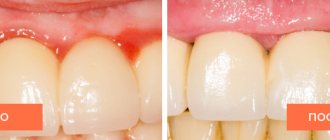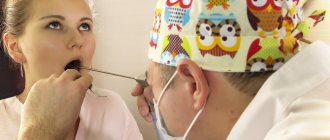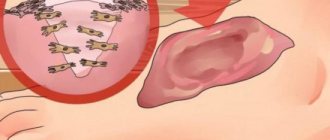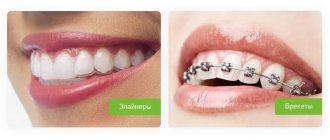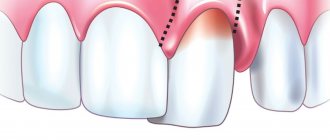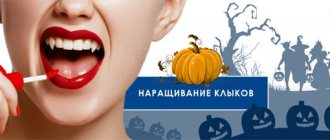Author of the article:
Soldatova Lyudmila Nikolaevna
Candidate of Medical Sciences, Professor of the Department of Clinical Dentistry of the St. Petersburg Medical and Social Institute, Chief Physician of the Alfa-Dent Dental Clinic, St. Petersburg
Weak and loose gums are a problem that many people face today. As a rule, the appearance of this defect is preceded by inflammatory periodontal diseases, such as gingivitis and periodontitis. Patients with such diseases suffer from a number of unpleasant symptoms:
- Severe redness, swelling of the gums;
- Bleeding while eating or brushing teeth;
- Tooth mobility;
- The formation of “pockets” - spaces between the tooth and gum, in which food debris, bacterial mass, and, in some cases, pus accumulate;
- Exposure of the cervical area of the teeth, and in severe cases, the roots.
- Strong, pungent odor from the mouth.
The listed symptoms are only the most harmless consequence of weakening gum tissue. In the absence of proper treatment, it threatens the loss of teeth, including healthy ones. That is why strengthening the gums and teeth is the primary task of the dentist and periodontist when treating patients with such problems. However, today it is also possible to strengthen gums at home. You will learn how to strengthen your gums and teeth yourself from our material.
Causes associated with dental diseases
The cause of loose teeth in the gums can be various dental diseases, such as periodontitis, periodontal disease, periodontitis and gingivitis. Incorrect bite can also trigger the appearance of this disease.
With gingivitis, many bacteria live in the oral cavity, which cause bleeding gums and, as a result, loosening of teeth.
With periodontitis, the same symptoms are present, but they are also accompanied by bad breath and inflammatory processes in the gums begin. The cause of both diseases is poor oral hygiene.
Periodontal disease is not associated with inflammatory processes and is accompanied by a decrease in the bone walls between all teeth, resulting in bleeding and itching in the gums, and the teeth become mobile and their sensitivity increases.
Building up during a recession
Many periodontal diseases lead to exposed tooth roots. Then the smile becomes ugly. The coronal part of the units involved in the pathological process appears excessively long. Suitable conditions are created for the active spread of caries.
Unfortunately, it is impossible to close or at least somehow disguise the recession on your own. In such a situation, only a dental surgeon can help. Therefore, you should not waste time studying traditional recipes.
If the disorder is caused by incorrect placement of the frenulum in a child, plastic surgery is indicated. It is performed under local anesthesia. As soon as the normal length of the operated fold is restored, the doctor works with the gum and eliminates its deficiency using a natural/artificial flap graft.
In what other cases is flap surgery performed?
In addition to shortened frenulum and recession, the flap technique is used if:
- the depth of periodontal pockets exceeds five millimeters;
- Gum hypertrophy caused by advanced inflammation was diagnosed;
- moderate/severe periodontal disease was detected;
- teeth are crowded and overlap each other;
- a significant lack of periodontal layers is recorded;
- dental roots are exposed;
- individual units are loose;
- the jaw bones began to collapse, the teeth were weakly held in the sockets.
Returning the original volume to the operated area creates optimal conditions for maintaining oral health and preventing the spread of infection. The doctor administers a local anesthetic and makes an incision in the area of the exposed roots. Removes necrotic accumulations and dead epithelial cells.
Then he takes a flap from the palate and transplants it into the problem area. Suturing the wound. As soon as the regeneration processes are completed, the suture material is removed.
Causes of disease not related to gum disease
Dental disease is not the only factor that causes loose teeth. This process can occur for a number of other reasons:
- As a result of genetic predisposition to the disease.
- Weakening of the immune system.
- Diabetes.
- Hormonal imbalances.
- Psoriasis.
- Trauma to the maxillofacial area.
- Arthritis.
Only a dentist can correctly determine the cause of the disease. If the teeth are loosened as a result of a strong blow, the doctor sends the patient for an x-ray for a more detailed diagnosis, and then decides on subsequent treatment. If the cause is a chronic disease, the doctor will prescribe dental procedures or prescribe the appropriate medication to strengthen the gums.
Changing the base line of the incisors
In 70% of cases, people decide to have plastic surgery precisely because of their very exposed upper parts. They are visible even when a person is simply talking, not to mention laughing or openly smiling.
The problem may be congenital or caused by atrophy/hypertrophy of periodontal structures or dental anomalies. The intervention to eliminate the defect is carried out in the surgical office of the dental center. The patient is given local anesthesia, after which treatment immediately begins. Once the intervention is completed, the person can go home.
In order for regeneration to take place without complications, it is necessary to strictly follow medical prescriptions and carefully follow the rules of care for the operated area. Come for scheduled examinations on the appointed days.
Diet and vitamins
Proper, balanced nutrition is necessary for gum health. To strengthen the mucous membranes and blood vessels, you need to eat foods high in vitamin C, such as citrus fruits and green leafy vegetables. Vitamin K, found in large quantities in green vegetables and herbs, has a similar effect. Antioxidants and tannins contained in green tea and red wine have an anti-inflammatory and healing effect, slowing down the aging process. In addition, it is important to consume enough phosphorus, calcium and zinc - they are contained in seafood, garlic and onions, and dairy products.
Vitamin complexes are well suited as an additional source of nutrients - in particular, the vitamin-mineral complex for teeth ASEPTA. It contains vitamins A, B3 and B6, C, D3, as well as coral calcium and green tea extract. In addition, coenzyme Q10, which is contained in the complex, has a powerful regenerating effect and restores damaged gum tissue.
Consequences of atrophy
Many people believe that the loss of one or two teeth is not serious, especially if it is not noticeable to others. In fact, the decrease in jaw bone tissue gradually leads to both cosmetic defects and disruptions in the functioning of internal organs.
Unpleasant consequences of atrophy:
- the shape of the face changes: cheeks and lips sink;
- the formation of facial wrinkles accelerates;
- a lisp and unclear diction appear;
- poor-quality chewing leads to gastrointestinal problems and a lack of vitamins and nutrients;
- removal of a tooth causes displacement of its “neighbors” and the entire dentition, increasing the risk of losing other teeth;
- installation of the implant becomes seriously difficult.
Folk remedies for treating illness
Regular rinsing of the mouth with special solutions or decoctions of medicinal plants is an excellent remedy for strengthening the gums. For this purpose, you can use decoctions of oak bark, eggplant peel, and horseradish. The most popular herbs for strengthening gums are chamomile, sage, St. John's wort, mint, and burdock.
Four folk recipes for rinsing to strengthen gums:
- Tea tree oil is an effective remedy for strengthening weak gums due to its ability to heal wounds and fight bacteria. To prepare a solution that needs to be used to rinse the mouth, take 2 drops of oil and half a glass of clean water.
- One of the popular folk recipes is a tincture made from a mixture of linden blossom and oak bark in equal proportions. To prepare it, just take a teaspoon of each component and pour 2 cups of boiling water over them. You should rinse your mouth with the resulting product after each meal.
- You can disinfect the oral cavity with cognac. To do this, you need to rinse it with a small amount of drink.
- Burdock decoction. The product should be used at least twice a day. To prepare it, you need to boil a tablespoon of the herb in 500 milliliters of water, then cool and strain through cheesecloth or a sieve.
To strengthen the gums and teeth, it is recommended to massage with the thumb and forefinger. The gums are treated with vertical massaging movements - from one tooth to another. Each section should be worked for 20 seconds. To increase efficiency, you can carry out the procedure by first dipping your fingers in honey or tea tree oil.
To strengthen the gums, it is recommended to use lotions:
- Plantain juice helps a lot. A cotton or gauze swab is moistened in it and applied to the gum.
- A decoction of young pine needles. To prepare the lotion, you need to boil 3 tablespoons of needles in 200 milliliters of water for 10 minutes. After this, the product is infused for at least 7 hours. A cotton swab dipped in the broth is applied to the sore gums.
Correction materials
To compensate for the lack of gingival structures, you need to get material for transplantation from somewhere. This may be the patient's own flap obtained from the soft palate. It is also permissible to use an artificially created barrier membrane or a special collagen matrix.
It is believed that natural “blanks” are a more preferable option. They take root well, which means the likelihood of rejection is minimized, and the recovery period after the intervention is significantly reduced.
Ointments and gels
The main advantage of gels and ointments compared to rinses is their ability to remain longer on the surface of the gum mucosa - and, as a result, provide a therapeutic effect for a longer time. ASEPTA healing gel contains propolis, a component of natural origin that has antibacterial, anti-inflammatory and regenerating effects. Thanks to this, the gel, when used regularly, can eliminate almost all the unpleasant symptoms that accompany weakening gums, as well as have a positive effect on the condition of the tissues themselves. The product is applied twice a day to the affected areas (necessarily after thorough brushing of the teeth). After using it, do not consume food or liquid for half an hour. This gel allows you to quickly strengthen your gums at home.
An equally effective remedy is the adhesive balm ASEPTA. The sticky pectin base prevents saliva from washing off the balm from the surface of the mucous membrane - its antimicrobial effect lasts more than half an hour. The balm contains powerful antiseptic components - chlorhexidine and metronidazole, which can prevent the development of inflammatory gum diseases - gingivitis and periodontitis.
Toothpaste for strengthening gums
Therapeutic and prophylactic toothpastes are also an excellent tool for combating looseness of gingival tissue. Proper brushing of teeth is effective in itself - by massaging the gums with a brush, we improve blood circulation in the tissues and remove plaque, which is a constant source of infectious danger. In addition, many pastes contain antiseptic components that kill pathogens. However, it should be remembered that such pastes cannot be used for a long time, as this may negatively affect the state of the natural microflora of the teeth.
For regular use, pastes based on natural ingredients are better suited. For example, ASEPTA and ASEPTA Sensitive toothpastes contain extracts of calendula, sage, St. John's wort, sweet clover, calamus and other medicinal plants that relieve inflammation, eliminate bleeding and have a mild antiseptic effect. ASEPTA Sensitive paste also contains minerals - potassium citrate and hydroxyapatite, which increase the resistance of teeth to caries.
How to strengthen teeth and gums? Basic recommendations
List of recommendations for strengthening gums:
- Use special toothpastes.
- Introduce dairy products into your diet, as well as foods containing large amounts of vitamin D.
- Use rinse aids.
- Use floss to clean teeth in hard-to-reach areas.
- See your dentist regularly to check the condition of your teeth and gums.
See your dentist regularly to check the condition of your teeth and gums.
Cystic neoplasms
A dental cyst is a tumor-like benign formation that is located in the periodontal area on the upper or lower jaw. Outwardly, it resembles a bubble, which is filled with pasty or liquid contents of bacteria and dead cells. Many dentists consider it a pseudotumor and do not classify it as a true tumor.
In the article Stom-Firms.ru we will tell you why the pathology appears, what types it has, and also describe how it is removed. At the end of the publication you will find recommendations for preventing the disease.
Consumer Reviews
Kotty about Asepta adhesive gum balm (otzovik.com)
“I had to purchase this adhesive balm because the dentist diagnosed me with periodontal disease. Therefore, when I have gum inflammation, I use this drug in courses every 6 months. I must note that the drug very quickly exerts its healing effect on the gums. The pain goes away immediately after starting treatment.
The dentist recommended that I lubricate my gums at night, once a day for 7 days.
Having studied the composition, I saw there such a substance as metronidazole and chlorhexidine. I realized that metronidazole is still an antibiotic. But since I was prescribed this medicine, I was calm. Although, frequent use of substances such as chlorhexidine and metronidazole on the skin and mucous membranes is undesirable, because the protective properties that the mucous membrane and skin should produce may cease to be produced. The dentist told me this too. Therefore, it is very important to use such products only for their intended purpose and strictly according to the instructions.
Of the indicated effects of the balm on the gums, the following were indicated:
- pronounced antibacterial effect on the gums;
- relieving inflammation and bleeding gums;
- breath freshening.
The package also contained a special plastic spatula, which was used to apply the balm to the gums. I must say that it is very comfortable. The balm itself is very thick and hardens after application. But the taste is generally tolerable.
I am satisfied with the effect of the balm. Good quality. It's not that expensive, considering that it lasts a long time. I recommend".
Minuto4ka about Asepta mouthwash (otzovik.com)
“Mint is an acquired taste, in everything. For example, I can completely tolerate it and love it. But I know a lot of people who can’t stand tongue-biting additives.
These are the first associations that arose for me when I first used this mouthwash.
It is sweet and has a lime flavor. And absolutely non-biting.
They prescribed it to me for absolutely no reason, of course.
My dentist prescribed it for me. For gums, which really bother me due to the periodic eruption of wisdom teeth. Which I'm terrified of deleting.
The rinse aid is sold in pharmacies, I haven’t seen it in supermarkets, which captivates me. I would like to believe that it is truly therapeutic in nature. They prescribed me this mouthwash along with Asepta dental gel. I don’t know which of them helped in the end. Maybe all together.
I think the advantage of the bottle is the presence of a measuring cup. It is very comfortable. Not all mouthwashes have it...
... overall I recommend it. At least it will win over its audience with its taste.”
Sources:
- Study of the clinical effectiveness of the use of therapeutic and prophylactic agents of the ASEPTA series in the treatment of inflammatory periodontal diseases in children and adolescents (I.V. Klimova) Irina Vladimirovna Klimova, Candidate of Medical Sciences, Associate Professor of the Department of Pediatric Dentistry, Novosibirsk State Medical University. Department of Pediatric Dentistry, Novosibirsk State Medical University.
- Clinical studies of antisensitive toothpaste “Asepta Sensitive” (A.A. Leontyev, O.V. Kalinina, S.B. Ulitovsky) A.A. LEONTIEV, dentist O.V. KALININA, dentist S.B. ULITOVSKY, Doctor of Medical Sciences, Prof. Department of Therapeutic Dentistry, St. Petersburg State Medical University named after. acad. I.P. Pavlova
- Report on clinical trials to determine/confirm the preventive properties of commercially produced personal oral hygiene products: mouth rinse "ASEPTA PARODONTAL" - Solution for irrigator." Doctor of Medical Sciences Professor, Honored Doctor of the Russian Federation, Head. Department of Preventive Dentistry S.B. Ulitovsky, doctor-researcher A.A. Leontiev First St. Petersburg State Medical University named after academician I.P. Pavlova, Department of Preventive Dentistry.
- The role of anti-inflammatory rinse in the treatment of periodontal diseases (L.Yu. Orekhova, A.A. Leontyev, S.B. Ulitovsky) L.Yu. OREKHOVA, Doctor of Medical Sciences, Prof., Head of Department; A.A. LEONTIEV, dentist; S.B. ULITOVSKY, Doctor of Medical Sciences, Prof. Department of Therapeutic Dentistry of St. Petersburg State Medical University named after. acad. I. P. Pavlova
